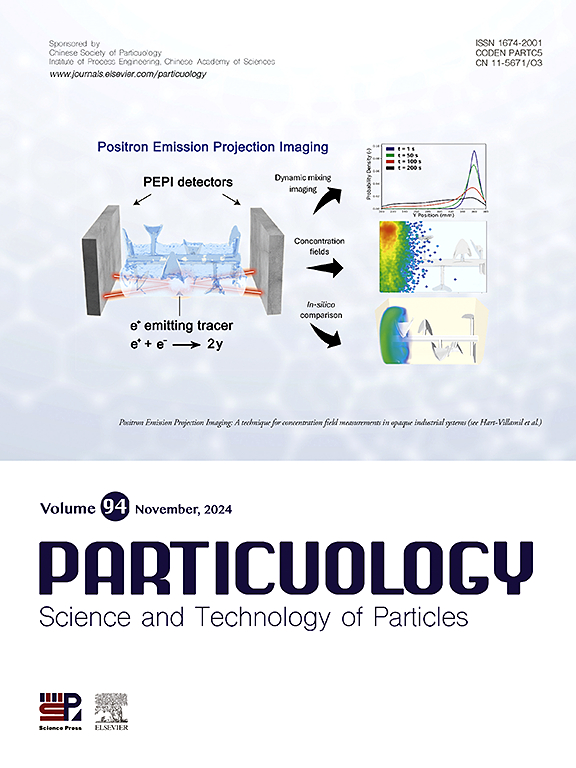Modelling of heat transfer in moving granular assemblies with a focus on radiation using the discrete ordinate method: A DEM-CFD approach
IF 4.1
2区 材料科学
Q2 ENGINEERING, CHEMICAL
引用次数: 0
Abstract
Discrete Ordinates Method (DOM) is a model for thermal radiation exchange in opaque media. In this study, the DOM formulation is employed within the framework of the Discrete Element Method coupled with Computational Fluid Dynamics (DEM-CFD), thus including full radiative heat exchange among the phases involved. This is done by adjusting the absorption coefficient, emission coefficient, and net radiative heat flux of particles by incorporating local porosity into equations. A key objective is to represent radiation propagation for different packing densities in packed beds accurately.
The model is validated by comparing the results with available data from the literature for simulations with a P1 radiation model and corresponding experiments. The validation configuration is a heated box filled with spherical particles under vacuum conditions.
As an application example, the radiative heat exchange between an enclosure at high temperature and moving layers of spherical particles concurrently passed by a gas in crossflow is studied. Three packing densities (dilute, moderate, and dense) are examined to evaluate radiation penetration into the particle ensemble. Convective and contact heat transfer are also considered. The DEM-CFD coupling is a non-resolved approach, where the influence of particles on the flow field is accounted for by momentum and energy source terms together with a porosity field (Averaged Volume Method (AVM)).
Effect of convective, conductive and radiative heat transfer is analysed based on the evolution of incident radiation flux, spatial distributions of particle surface and fluid temperatures, and particle temperature histograms. It becomes obvious that radiation dominates the system, and that packing density defines the penetration depth of radiation. Conduction mainly leads to a smoothening of particle temperature distribution in the system.

求助全文
约1分钟内获得全文
求助全文
来源期刊

Particuology
工程技术-材料科学:综合
CiteScore
6.70
自引率
2.90%
发文量
1730
审稿时长
32 days
期刊介绍:
The word ‘particuology’ was coined to parallel the discipline for the science and technology of particles.
Particuology is an interdisciplinary journal that publishes frontier research articles and critical reviews on the discovery, formulation and engineering of particulate materials, processes and systems. It especially welcomes contributions utilising advanced theoretical, modelling and measurement methods to enable the discovery and creation of new particulate materials, and the manufacturing of functional particulate-based products, such as sensors.
Papers are handled by Thematic Editors who oversee contributions from specific subject fields. These fields are classified into: Particle Synthesis and Modification; Particle Characterization and Measurement; Granular Systems and Bulk Solids Technology; Fluidization and Particle-Fluid Systems; Aerosols; and Applications of Particle Technology.
Key topics concerning the creation and processing of particulates include:
-Modelling and simulation of particle formation, collective behaviour of particles and systems for particle production over a broad spectrum of length scales
-Mining of experimental data for particle synthesis and surface properties to facilitate the creation of new materials and processes
-Particle design and preparation including controlled response and sensing functionalities in formation, delivery systems and biological systems, etc.
-Experimental and computational methods for visualization and analysis of particulate system.
These topics are broadly relevant to the production of materials, pharmaceuticals and food, and to the conversion of energy resources to fuels and protection of the environment.
 求助内容:
求助内容: 应助结果提醒方式:
应助结果提醒方式:


